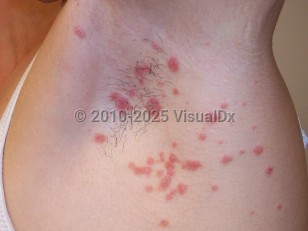Guttate psoriasis in Adult
Alerts and Notices
Important News & Links
Synopsis

Guttate psoriasis is a variant of psoriasis that is characterized by an acute, generalized eruption of small, discrete, raindrop-like (hence the name, guttate) papules with fine scale. It most commonly occurs in the 2-3 weeks following an upper respiratory infection and is associated with an elevated anti-streptolysin O, anti-DNase B, or streptozyme titer. Guttate psoriasis can be pruritic, and postinflammatory pigmentary changes can follow. However, scarring and systemic symptoms such as fever, malaise, lymphadenopathy, myalgias, and arthralgias are typically not present.
Current evidence supports the theory that plaque psoriasis and guttate psoriasis are similar in that an environmental factor triggers an immune reaction in a genetically susceptible individual. The environmental factor in the case of guttate psoriasis is often a streptococcal infection, and a T-cell driven immune reaction is elicited, leading to increased type 1 helper T-cells (Th1) activity and increased interferon gamma (IFN-g) and interleukin-2 (IL-2) cytokine levels. Regarding a genetically susceptible host, it has been demonstrated that HLA-Cw*0602-positive patients are more likely to develop guttate psoriasis.
Guttate psoriasis occurs in all races, both sexes, and is most commonly seen in children and young adults younger than 30. The clinical course is unpredictable. In children, spontaneous remission over weeks to months is common, while in young adults, it may represent the first stage in the development of chronic plaque psoriasis.
While streptococcal infection is the most common trigger of guttate psoriasis, other infections, such as varicella and Pityrosporum ovale, and drugs, such as TNF-alpha inhibitors, have also been implicated.
Immunocompromised Patient Considerations:
The prevalence of psoriasis in patients with HIV is approximately 5%, and it is associated with a more severe clinical course. Psoriasis may pre-exist in the patient with HIV or manifest as a progression of the virus.
Current evidence supports the theory that plaque psoriasis and guttate psoriasis are similar in that an environmental factor triggers an immune reaction in a genetically susceptible individual. The environmental factor in the case of guttate psoriasis is often a streptococcal infection, and a T-cell driven immune reaction is elicited, leading to increased type 1 helper T-cells (Th1) activity and increased interferon gamma (IFN-g) and interleukin-2 (IL-2) cytokine levels. Regarding a genetically susceptible host, it has been demonstrated that HLA-Cw*0602-positive patients are more likely to develop guttate psoriasis.
Guttate psoriasis occurs in all races, both sexes, and is most commonly seen in children and young adults younger than 30. The clinical course is unpredictable. In children, spontaneous remission over weeks to months is common, while in young adults, it may represent the first stage in the development of chronic plaque psoriasis.
While streptococcal infection is the most common trigger of guttate psoriasis, other infections, such as varicella and Pityrosporum ovale, and drugs, such as TNF-alpha inhibitors, have also been implicated.
Immunocompromised Patient Considerations:
The prevalence of psoriasis in patients with HIV is approximately 5%, and it is associated with a more severe clinical course. Psoriasis may pre-exist in the patient with HIV or manifest as a progression of the virus.
Codes
ICD10CM:
L40.4 – Guttate psoriasis
SNOMEDCT:
37042000 – Guttate psoriasis
L40.4 – Guttate psoriasis
SNOMEDCT:
37042000 – Guttate psoriasis
Look For
Subscription Required
Diagnostic Pearls
Subscription Required
Differential Diagnosis & Pitfalls

To perform a comparison, select diagnoses from the classic differential
Subscription Required
Best Tests
Subscription Required
Management Pearls
Subscription Required
Therapy
Subscription Required
References
Subscription Required
Last Reviewed:05/18/2017
Last Updated:08/07/2023
Last Updated:08/07/2023
 Patient Information for Guttate psoriasis in Adult
Patient Information for Guttate psoriasis in Adult
Premium Feature
VisualDx Patient Handouts
Available in the Elite package
- Improve treatment compliance
- Reduce after-hours questions
- Increase patient engagement and satisfaction
- Written in clear, easy-to-understand language. No confusing jargon.
- Available in English and Spanish
- Print out or email directly to your patient
Upgrade Today

Guttate psoriasis in Adult

